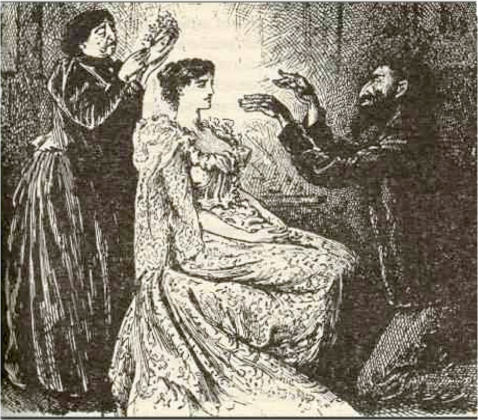How Svengali Lost His Jewish Accent
The pop juggernaut Beyoncé recently made headlines when she confessed her plans for world pop domination to an AP reporter. She said:
“I am starting my company, my label. I want to create a boy band. I want to continue to produce and do documentaries and music videos. I eventually want to start directing for other artists.”
While Beyoncé’s business ambitions are hardly newsworthy—like many a multitasking pop idol, she helms several successful ventures, including a line of perfumes and a ready-to-wear fashion line—the announcement that she wants to be a musical impresario puts Beyoncé in more relatively selective company, especially as a woman. “Beyoncé as music industry boy band Svengali?” asked Amy Sciaretto, a tad incredulously, on PopCrush, “Yes, it’s true.”
In pop music writing, the idea of the Svengali pops up with regularity, usually to describe a man obsessively managing the careers of his younger, often vulnerable, charges. Classic examples include Phil Spector and the Ronettes. Berry Gordy and Diana Ross. Malcolm McLaren and the Sex Pistols. Lou Pearlman and the Backstreet Boys. To call Beyoncé a Svengali is both to insert her into this overwhelmingly male trajectory and to associate her, rather unflatteringly, with a long tradition of the producer-control freak, officiously meddling while passing himself off as his protégé’s protective sponsor.
Both associations, in fact, take us back to the origin of the term Svengali, from Trilby, an 1894 bestseller by the English writer and illustrator George Du Maurier. In that work, Trilby, a young Englishwoman of great likability but dubious honor (she is the daughter of a barmaid, and occasionally works as an artist’s model), is living la vie bohème in Paris, where she encounters Svengali, a sinister but charismatic musical genius who uses his mesmeric powers to turn her into the singing sensation of the European concert stage. Trilby can only sing, however, under Svengali’s spell—she must literally look at him while she performs—and so when one day he expires, mid-performance, of a weak heart, she loses her own vocal powers and later dies. The cause of her death is partly shock, but partly unrequited love. For although Svengali, a rather hideous Jew, had vainly sought Trilby’s affections, which she could only return when in hypnotic thrall to him, Trilby has long been in love with Little Billie, the handsome scion of a wealthy English family, who cannot marry her because she is tragically beneath him in rank.
First serialized in Harper’s, Trilby was a transatlantic sensation, igniting what the press at the time, neatly anticipating Beatlemania, dubbed “Trilbymania.” Trilby’s success—and Svengali’s emergence into our cultural lingua franca—is attributable to its canny marriage of late 19th-century sentimentalism (the plot of a heroine who desires the unattainable good man but succumbs to the ogling bad man) with contemporary anti-Semitism, particularly the Wagnerian stereotype of the cultured Jew as musical parasite. In Das Judenthum in der Musik (Judaism in Music), an 1850 pamphlet, Wagner infamously excoriated Jewish musicians, claiming their inherent artistic inferiority relative to Gentiles.
It is important here that although Wagner was partly responding to the influx of Polish and other Eastern European Jewish peasants in 19th-century Germany, his attack was primarily aimed at the assimilated German-Jewish bourgeoisie. It was those Jews, as Wagner’s contemporary, the German music critic and journalist Franz Brendel put it, who “have fallen into a hopeless contradiction, i.e., of possessing our culture and yet remaining Jews, of wishing to be Jewish and Christian in one person.” Wagner’s Jew makes music in a tainted vernacular. Jews “can only imitate the speech of any European nation,” he wrote, “and because song is an extension of speech, … can never be great singers.”
Du Maurier’s Svengali, Polish-born but culturally German, enters late 19th-century Anglophone culture bearing the marks of the Wagnerian stereotype. In the novel he is introduced as a tall bony individual of any age between thirty and forty-five, of Jewish aspect, well-featured but sinister.
“He was very shabby and dirty… His thick, heavy, languid, lusterless black hair fell down behind his ears on to his shoulders, in that musician-like way that is so offensive to the normal Englishman. He had bold, brilliant black eyes, with long heavy lids, a thin, sallow face, and a beard of burnt-up black, which grew almost from under his eyelids; and over it his moustache, a shade lighter, fell in two long spiral twists. He went by the name of Svengali, and spoke fluent French with a German accent and humorous German twists and idiom, and his voice was very thin and mean and harsh, and often broke into a disagreeable falsetto.”
In short, Svengali is a prototypical Jew of late 19th-century anti-Semitic fantasy: Jewish in “aspect” and Jewish in nature: Jewish in his effeminacy and his indeterminate age and nationality; Jewish despite his ennobling Germanness and cultural accomplishment; Jewish even in his mysterious one-word appellation, Svengali, a name that renders his character both cosmopolitan and menacingly foreign, like the villain of a Donizetti opera. Like all embodiments of stereotype, Svengali exudes an embarrassing surfeit of Jewishness; at one point, Du Maurier’s narrator refers to him as “a dark black Hebrew sweep”; at another, as “an Oriental Israelite Hebrew Jew.” He is a bottom-feeder even in the 19th-century hierarchy of European and English Jews: dark, accented, coarse in his mannerisms and customs, a repellent mixture of East and West.

Svengali hypnotizing Trilby as she prepares for a performance. Illustration by George Du Maurier, 1894
Although it was not the case in the late 19th century, when parents took to naming their daughters Trilby, ultimately Svengali would prove more culturally durable than Du Maurier’s heroine. Today, the term, if not the memory of its origins in a forgettable 19th-century fiction, persists as a prototype of the charismatic, driven, and authoritative male starmaker. Like Du Maurier’s Svengali, the Svengali of contemporary usage craves money, but is driven by something greater than wealth. Like the fictional character, he is often himself a gifted artist, and yet he can never be the frontman, only the guy behind the scenes. Above all, he excels at playing other performers, especially feminized ones, as his “instruments.” Like the Svengali who mesmerizes Trilby with his eyes, he is creepily alluring, exerting a mysterious power over his musical charges—at least until the spell wears off (which it inevitably does).
Svengali is one of three Jewish characters—the others are Shylock and Fagin—whose names have become archetypes in English. Yet whereas Shakespeare’s and Dickens’s characters name Jewish stereotypes—and one would think before calling, say, Lou Pearlman, impresario of the Backstreet Boys and ‘NSync, now serving a jail sentence at a federal penitentiary in Texarkana for his involvement in a Ponzi scheme, a “Shylock”—Svengali carries little trace of its specifically anti-Semitic provenance.
This isn’t a post-Holocaust occurrence. In the course of a few decades after the serialization of Trilby the figure of Svengali had been almost entirely stripped of his ethnic accent. Whereas an 1897 Viennese stage production of Trilby provoked anti-Semitic agitation—forebodingly, given what was to come, forcing the producers to recode Svengali as a Hungarian Gypsy—by 1902, the Kansas City, Kansas American Citizen records the usage of “Svengali” to name a man who mesmerizes respectable women. Caught up in the late Victorian vogue for hypnosis, early 20th-century Americans attributed to “real-life” Svengalis a range of moral infractions that could not be credited to the women who committed them. No reason save hypnotic enticement could be found to explain the 1905 case of a Michigan woman, the wife of a veterinarian, who ran away with a balding, middle-aged white man, before returning to him when the “hypnotic effect began to wear off.”
In the 1931 film Svengali, starring John Barrymore, which follows the novel very closely, Svengali is Semiticized (the actor speaks with an accent and wears a nose prosthesis) and yet, quite assiduously, not named as a Jew, although he is associated with the Orient. By the time of the 1983 made-for-TV movie Svengali, starring Jodi Foster as the pop star Zoe Alexander, not only is the anti-Semitism excised, but also the character Svengali is missing. In this post-Helen Reddy world, moreover, Foster’s character eventually outgrows the need for her old teacher-manager (Peter O’Toole), who in the film’s end must go hunting for new students.
.
It’s not particularly remarkable that we still use the term Svengali despite its reprehensible heritage. We still recite the schoolyard rhyme “eenie meenie miney moe,” with its roots in antebellum racial stereotype, and know well the minstrel stage song repertoire.
On the other hand, the fact that “svengali” has shed its associations with Jewish masculinity, all the while retaining something of the ambivalence of anti-Semitic stereotype, is noteworthy. Svengalis are useful in crafting modern pop mythologies. Where money is concerned, they deflect agency away from pop stars—who, notwithstanding the degree of commercialism of their music or the loudness of their boasts, are still not supposed to want wealth more than making art or pleasing their fans. More generally, the Svengali figure intercedes to “manage” the excess of their desire, otherwise so often unbound in their musical performances and their excessive real-life behavior. In his delightful romp of a book Starmakers and Svengalis, the British music journalist Johnny Rogan recounts how Tam Paton, the manager of the Bay City Rollers, was ultimately unable to contend with the bad-boy shenanigans of the “tartan teen sensations” whose squeaky clean image he had carefully cultivated. It’s perhaps not incidental here that Paton was gay, inhabiting a public sexual identity associated with otherness and indeterminacy, and thus hearkening back to the archetype’s Jewish origins.
Du Maurier’s character drew from the notion of Jewish men as perversely sexually powerful, combining attractiveness and repulsiveness in one body. Sexual titillation in Trilbyis never far from the surface. Ultimately, the figure of the Svengali is a means of containing and deflecting expressions of desire in pop music. Through him, we can personify the larger predations of the music industry, its constant hunger for product and profit. By vilifying the powerful headmaster of the Motown “charm school” or the evil father figure behind the Jackson 5, for example, we can turn our attention away from our own complicity in the objectifying dynamic.
Here Svengali’s power of hypnosis—the quality that attached itself to the Svengali-figure in the early 20th century—is a potent metaphor for what pop music does to us, in making us listen despite (sometimes) our intellectual rejection of it. In Du Maurier’s original illustration for his novel, Svengali is a spider who entraps Trilby in his web. Pop music is often like that spider and that web: supremely sticky and, once we are hooked, indifferent to our resistance.
—
Gayle Wald is Professor of English at George Washington University. She is author of Shout, Sister, Shout!: The Untold Story of Rock-and-Roll Trailblazer Sister Rosetta Tharpe (Beacon, 2007) and working on a book about the TV show Soul!, which brought a black power sensibility to PBS circa 1968-73. Wald’s post is adapted from a “Keyword” talk she gave at the Experience Music Project POP Music Conference in Los Angeles in March 2011, where it caused quite a stir. Peep these links to read some initial responses from music critic Bob Cristgau and Flavorwire.
Tags: 19th Century culture, anti-semitism, Gayle Wald, George Du Maurier, hypnosis, Jewish Stereotypes, Jodie Foster, John Barrymore, Lou Pearlman, Phil Spector, pop music, Starmakers and Svengalis, Svengali, Tam Paton, Trilby, Wagner
About gaylewald1
I am a professor at George Washington University in DC.11 responses to “How Svengali Lost His Jewish Accent”
Trackbacks / Pingbacks
- Mr. and Mrs. Talking Machine: The Euphonia, the Phonograph, and the Gendering of Nineteenth Century Mechanical Speech | Sounding Out! - November 12, 2018
- Svengali (Archie Mayo, 1931) | Make Mine Criterion! - August 14, 2015
- “A Sinister Resonance”: Joseph Conrad’s Malay Ear and Auditory Cultural Studies | Sounding Out! - July 9, 2015
- Gendered Voices and Social Harmony | - March 9, 2015
- Musical Encounters and Acts of Audiencing: Listening Cultures in the American Antebellum | Sounding Out! - December 30, 2013
- The Acoustics of Passing: Harriet Beecher Stowe’s Uncle Tom’s Cabin as Supremacist Remix | Sounding Out! - December 23, 2013
- Fiddling With Freedom: Solomon Northrup’s Musical Trade in 12 Years a Slave | Sounding Out! - December 16, 2013
- Sound at ASA 2011 « Sounding Out! - October 17, 2011
Leave a comment Cancel reply
This site uses Akismet to reduce spam. Learn how your comment data is processed.
ISSN 2333-0309
Translate
Recent Posts
- Rhetoric After Sound: Stories of Encountering “The Hum” Phenomenon
- Echoes of the Latent Present: Listening to Lags, Delays, and Other Temporal Disjunctions
- Wingsong: Restricting Sound Access to Spotted Owl Recordings
- Listening Together/Apart: Intimacy and Affective World-Building in Pandemic Digital Archival Sound Projects
- The Top Ten Sounding Out! Posts of 2023!
Archives
Categories
Search for topics. . .
Looking for a Specific Post or Author?
Click here for the SOUNDING OUT INDEX. . .all posts and podcasts since 2009, scrollable by author, date, and title. Updated every 5 minutes.























Trilby O’Ferrall is not an ”Englishwoman”. Her mother was ‘Scotch’ and her father Irish – “Trilby’s English was more or less that of her father, a highly-educated man; her mother, who was a Scotch woman, although an uneducated one, had none of the ungainliness that mars the speech of so many English women in that humble rank—no droppings of the h, no broadening of the o’s and a’s.”
LikeLike
Absolutely! Please do! Both Gayle Wald (author) and I are on board.–JSA, Editor-in-Chief, Sounding Out!
LikeLike
I’m the dance critic for the Ottawa Citizen newspaper in Canada (www.ottawacitizen.com). I’m writing a feature on the Royal Winnipeg Ballet’s new work, Svengali, by choreographer Mark Godden. I want to provide readers with a bit of background on the book Trilby and the Svengali archetype. I very much like your analysis and find it clear and succinctly presented. May I have permission to quote from this blog, with full attribution?
LikeLike